Cold weather, dust, and pollution can make your dog sneeze, sniffle, and tear up, much like us during the winter months. While mild watery eyes and a runny nose in dogs are often harmless, persistent or discoloured discharge may signal infection or a more serious condition. Let’s understand what these symptoms mean and when to see your vet.
What Is a Runny Nose in Dogs?
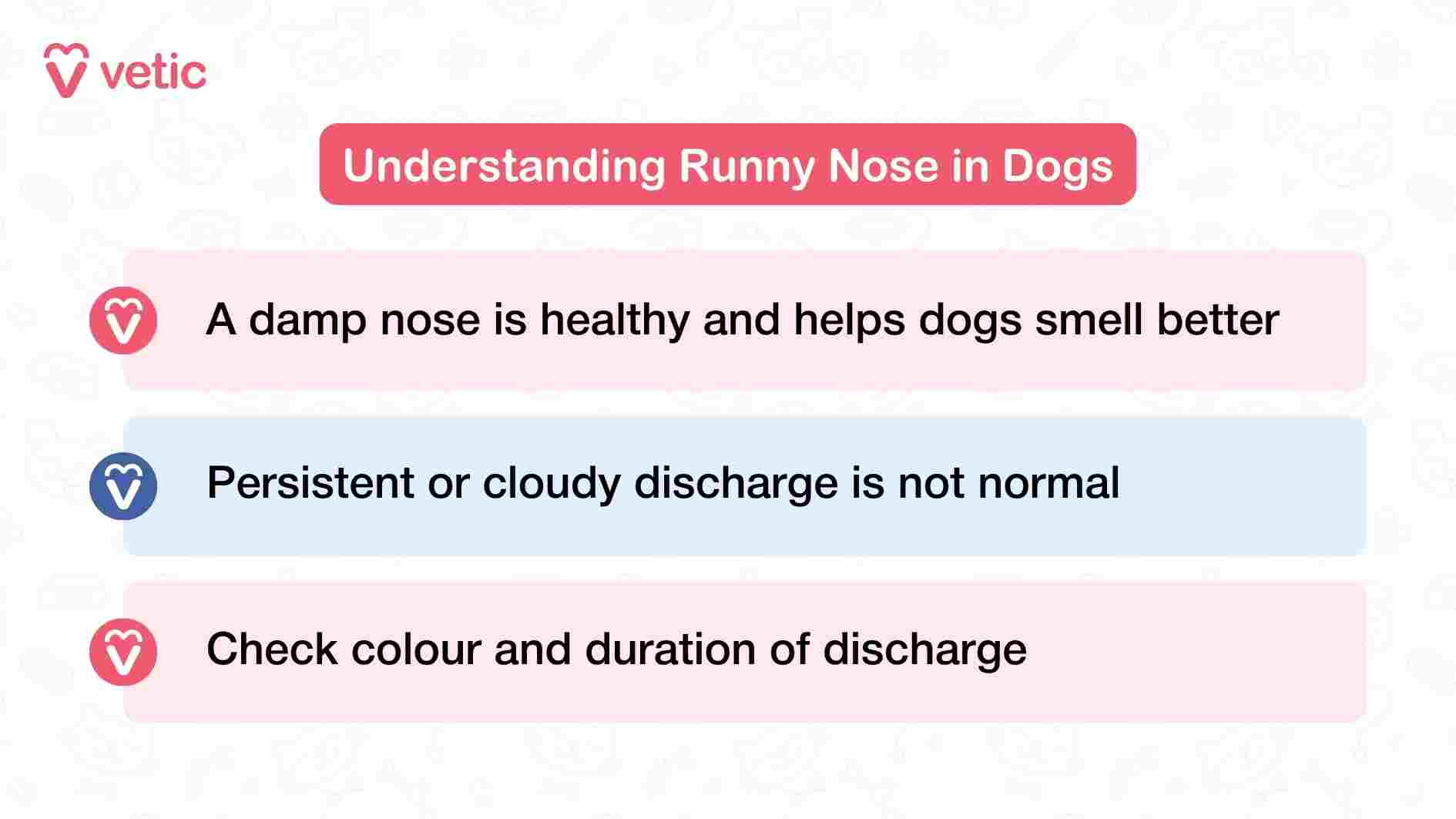
A healthy dog’s nose is naturally moist. The thin layer of mucus helps them smell better and keeps the nasal passages clean. However, when that moisture turns into continuous nasal discharge, it’s called a runny nose in dogs.
Is a Wet Dog Nose Always Normal?
Yes, if your dog’s nose is just slightly wet, there’s usually no reason to worry. Dogs often have damp noses after sleeping, drinking, or being outdoors. But if you notice constant dripping, cloudy mucus, or a foul smell, it’s time to look deeper.
When Should Pet Parents Be Concerned About Runny Noses in Dogs?
A runny nose that lasts more than a few days, worsens over time, or comes with other symptoms like coughing, sneezing, or loss of appetite may suggest illness.
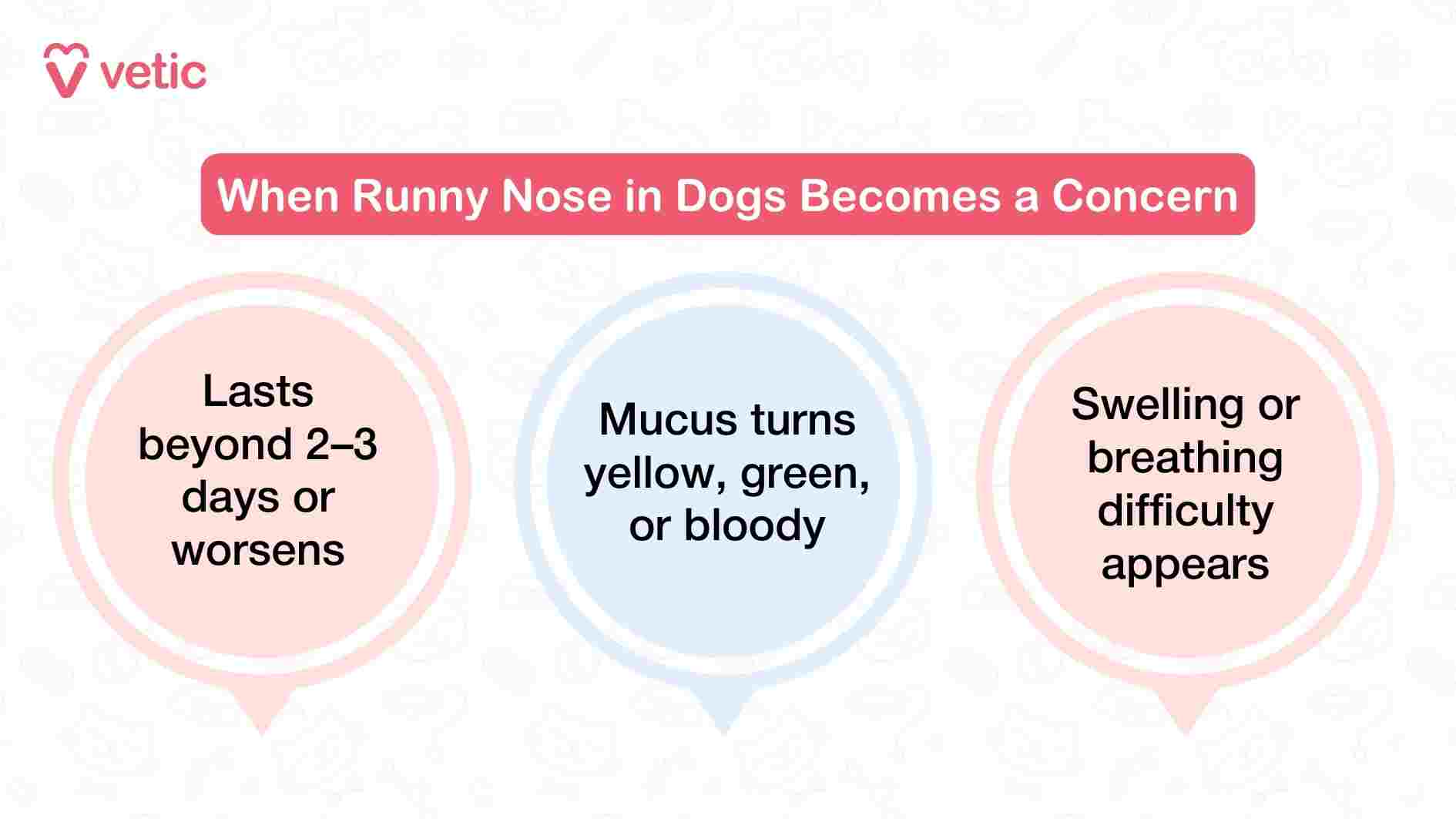
Watch for:
- Discharge that’s yellow, green, or bloody
- Laboured breathing or noisy inhalation
- Swelling around the eyes or face
- Reduced appetite or lethargy
If any of these occur, consult your nearest vet or pet clinic — especially if your dog is a puppy, senior, or brachycephalic (flat-faced) breed like a Pug or Shih Tzu, as they are more prone to nasal issues.
Nasal Discharge in Dogs: Signs Your Pet May Be Sick
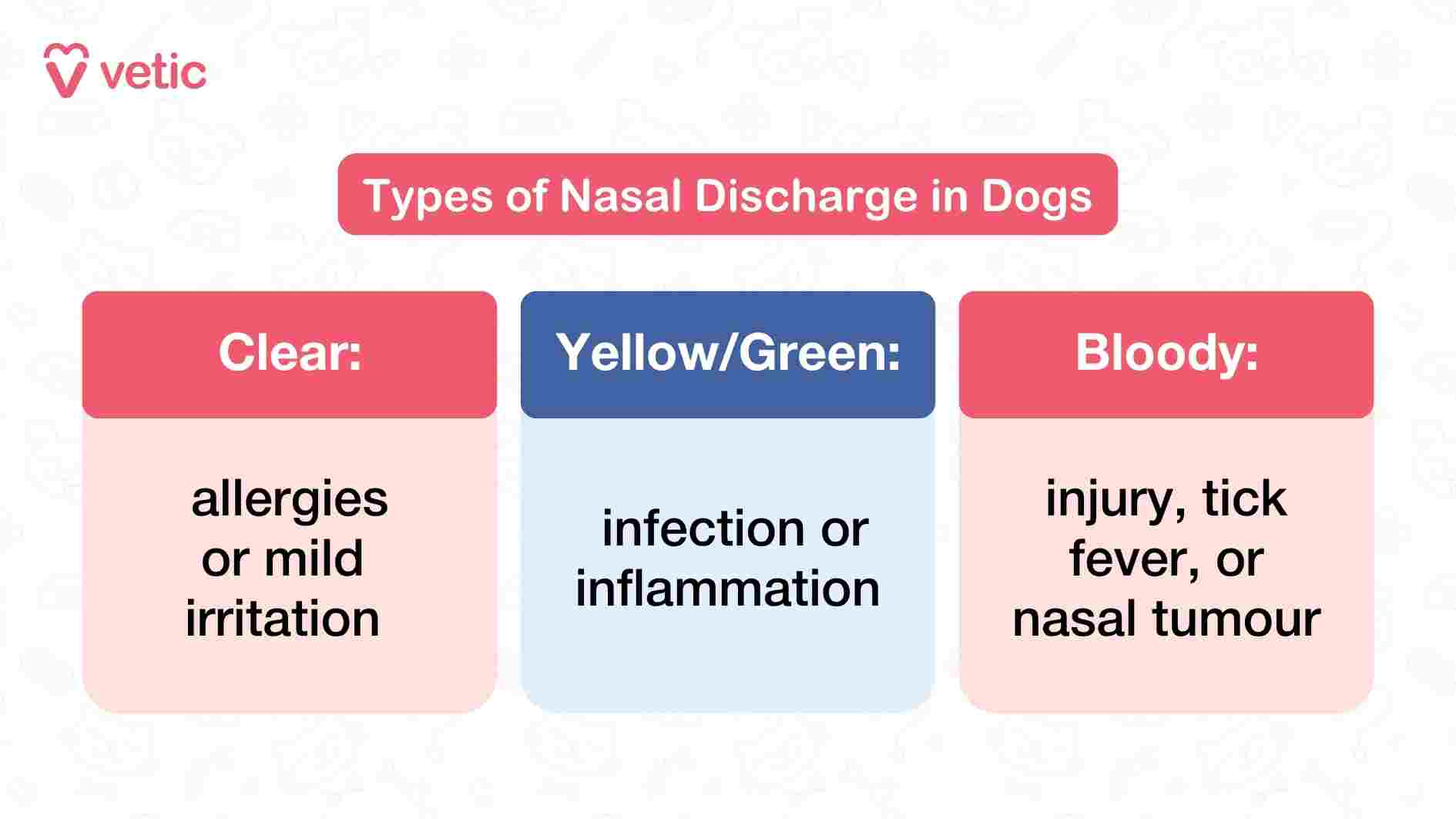
Clear Nasal Discharge in Dogs
If the fluid is clear and watery, it could simply be a response to seasonal allergies in dogs — triggered by pollen, dust, cleaning sprays, or air pollution.
Other mild causes include cold air exposure, excitement, or humidity changes.
However, if your dog keeps sneezing, rubbing their nose, or has red eyes along with clear discharge, it might be canine allergy symptoms. A vet may recommend antihistamines or mild anti-allergy medication after ruling out infections.
Thick or Colored Dog Nose Discharge
If your dog’s nasal discharge turns thick, yellow, or green, it often points to a bacterial or fungal infection.
Common culprits include:
- Kennel Cough: a contagious upper respiratory infection. Kennel cough symptoms in dogs include coughing, thick mucus, and watery eyes.
- Dog Cold or Upper Respiratory Infections: similar to human flu, these are more common in winter.
- Fungal infections: though rare, they can affect dogs exposed to damp or dusty environments.
Bloody Discharge from a Dog’s Nose
A bloody or mucus-streaked nose is a red flag. Possible causes include:
- Injury or foreign object inside the nose
- Tick fever or ehrlichiosis, common in Indian dogs
- Exposure to rat poison or toxins that prevent blood clotting
- Dog nasal tumor symptoms, such as persistent one-sided bleeding or facial swelling
If you notice blood or foul-smelling pus, visit your vet immediately. They may recommend blood tests or imaging to check for serious conditions like nasal tumors.
Watery Eyes in Dogs: Is It Normal or Serious?
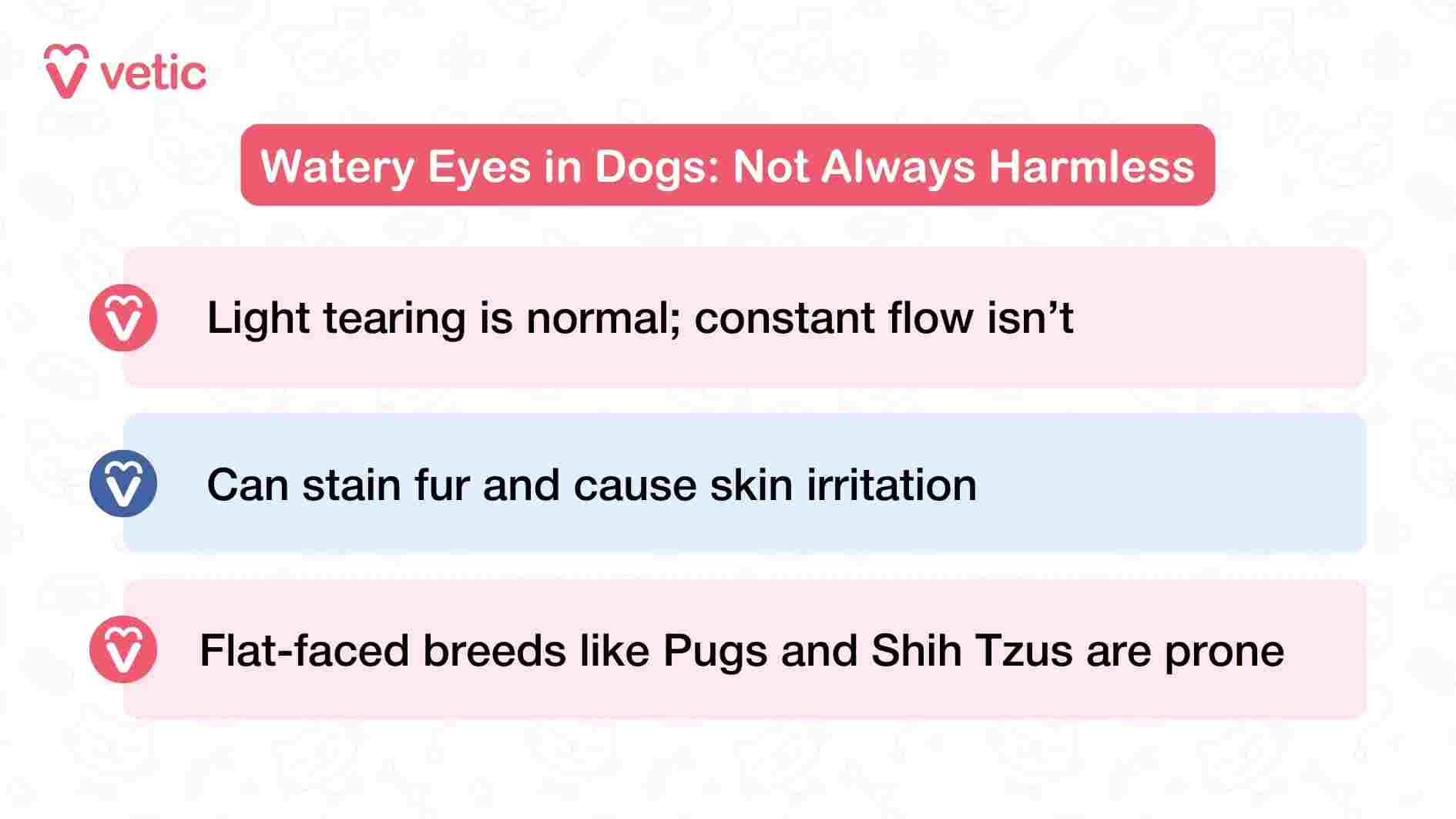
Occasional tears are normal. They help clean and lubricate your dog’s eyes. But constant watery eyes (also called epiphora) can lead to staining, infections, or eye irritation.
Dogs with short muzzles and protruding eyes — such as Pugs, Shih Tzus, Lhasa Apsos, and Indian Spitz — are particularly prone to watery eyes due to their facial anatomy.
Common Causes of Watery Eyes in Dogs
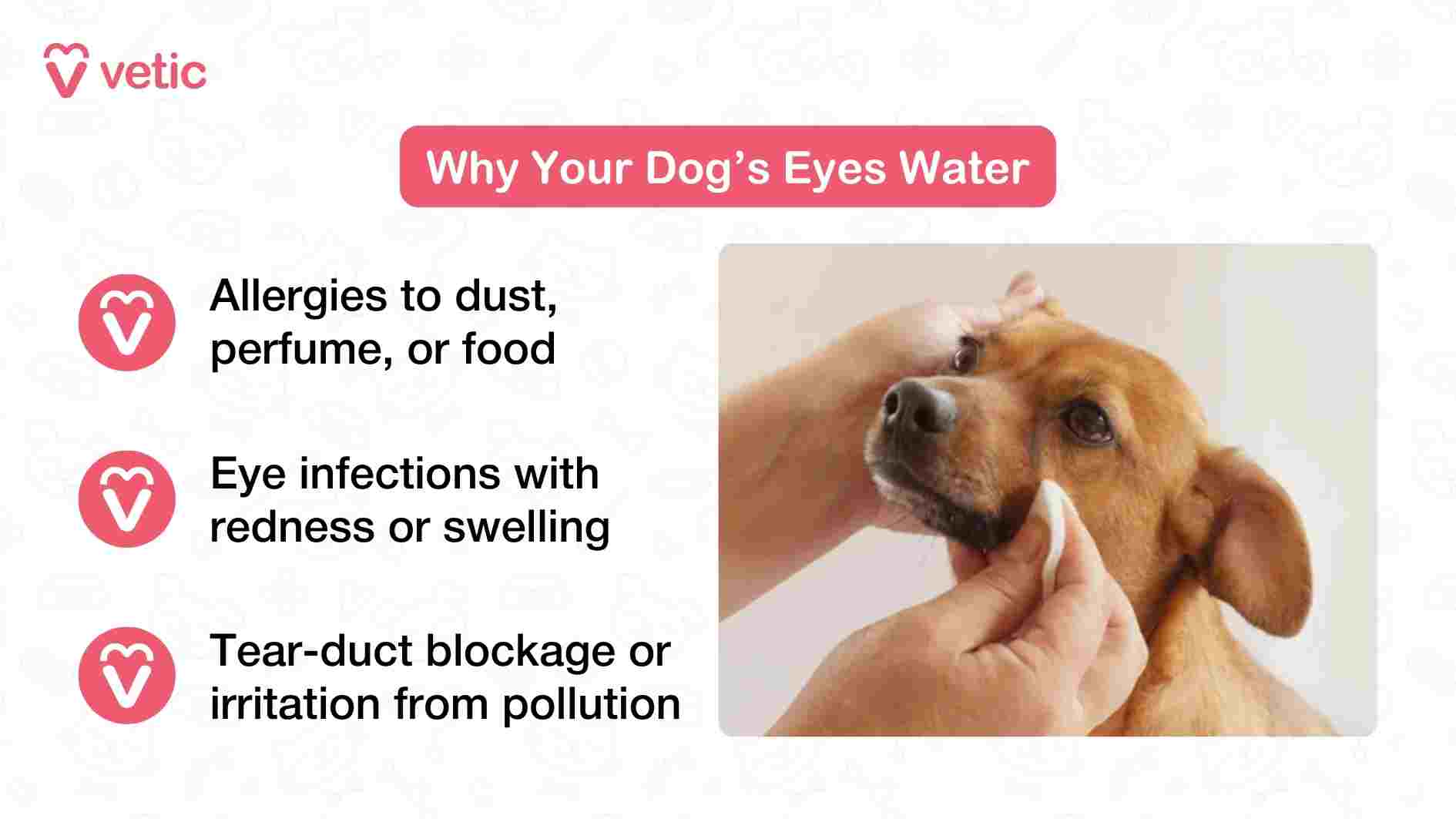
Allergies Causing Watery Eyes in Dogs
Allergies are one of the leading causes of runny noses and watery eyes in dogs. Triggers can include:
- Dust mites and pollen during spring or winter
- Room fresheners, incense, or perfume sprays
- Certain foods, such as dairy or wheat
Allergic dogs may also lick their paws excessively or have red, itchy skin. Managing the environment and using vet-approved antihistamines can help.
Eye Infections and Watery Eyes in Dogs
Eye infections caused by bacteria or viruses make the eyes red, swollen, and sensitive to light. Common signs:
- Thick yellow discharge
- Pawing at the eyes
- Swelling of the eyelids
Untreated infections can spread quickly, so timely veterinary care is essential.
Eye Irritation and Runny Eyes in Dogs
Sometimes, the cause is simpler – dust, smoke, or air pollution.
These irritants are common in Indian cities during winter, and Indie dogs who spend more time outdoors are especially affected.
Gently wiping the eyes with sterile saline can help, but persistent irritation needs a vet check.
Blocked Tear Ducts in Dogs
When tear ducts are blocked, tears overflow instead of draining into the nasal passage, leading to continuous watery eyes. This may need a professional flush or a minor corrective procedure.
Breed-Related Issues Causing Eye Discharge
Flat-faced (brachycephalic) breeds like Pugs, Shih Tzus, and Lhasa Apsos have shallow eye sockets that make tears spill over easily. Regular grooming around the eyes and keeping hair trimmed reduces infection risk.
Why Does My Dog Have Both a Runny Nose and Teary Eyes?
When both symptoms appear together, it often signals an underlying infection or allergy that affects both the respiratory and ocular systems.
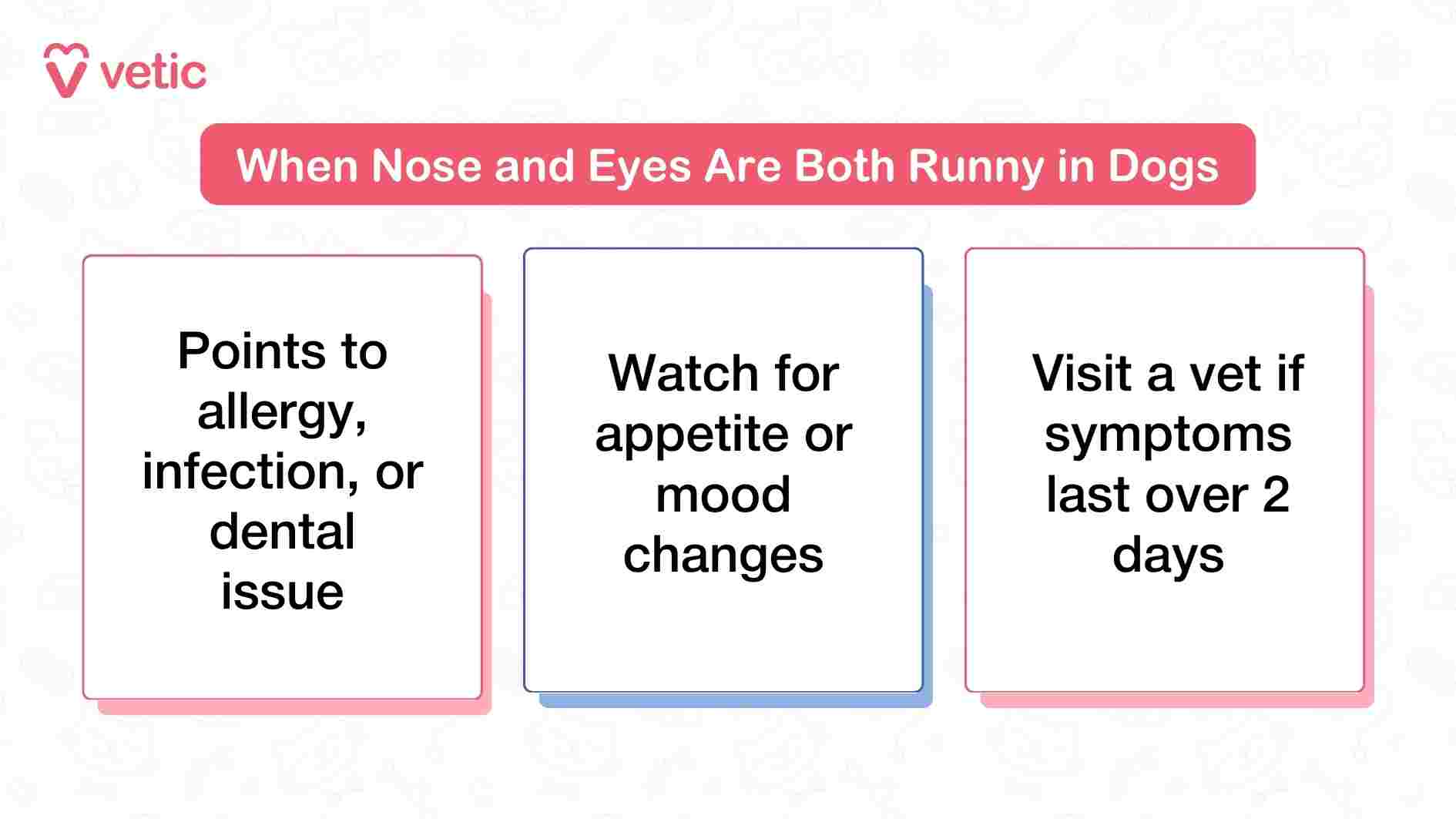
Allergies and Environmental Irritants in Dogs
Seasonal changes, smog, or household dust can irritate both the eyes and nasal passages. If your dog’s discharge is clear, and there’s sneezing or mild coughing, seasonal allergies in dogs could be the cause.
Respiratory Infections in Dogs: Signs and Risks
Dog upper respiratory infections, such as Canine Distemper Virus (CDV) or Canine Parainfluenza, cause coughing, sneezing, and watery eyes.
Puppies or unvaccinated dogs are more at risk. These infections spread easily between pets, so avoid dog parks or grooming salons until cleared by a vet.
Dental Disease in Dogs and Nasal/Eye Problems
Untreated tooth or gum infections can spread to the sinuses and cause nasal discharge in dogs.
Watch for bad breath, missing teeth, or reluctance to eat, these may signal a dental issue affecting your dog’s nasal tract.
Nasal Tumors or Polyps: Serious Causes in Dogs
Persistent thick or bloody nasal discharge with swelling or facial deformity may point to nasal polyps or tumors.
While not all growths are cancerous, prompt diagnosis using X-rays or CT scans ensures early treatment and better comfort for your pet.
Should I Take My Dog to the Vet for a Runny Nose and Watery Eyes?
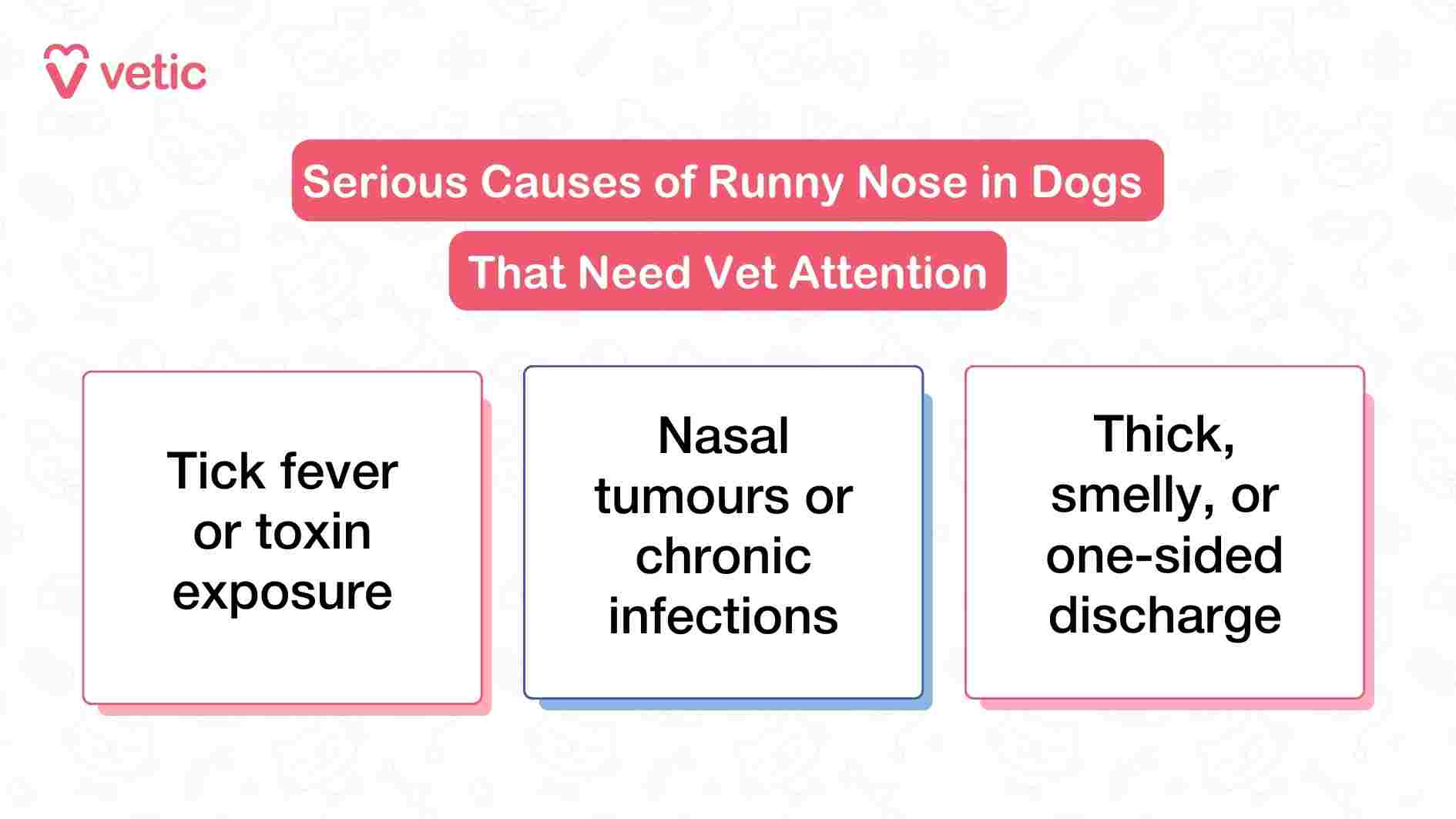
Yes, especially if:
- Symptoms last beyond 2–3 days
- Discharge becomes thick, coloured, or bloody
- Your dog shows lethargy, appetite loss, or breathing issues
These signs often require veterinary testing such as bloodwork, X-rays, or allergy panels to identify the cause and prevent complications.
How Are Dog Runny Nose and Watery Eyes Treated?
Home Remedies for Mild Runny Nose in Dogs
For mild cases due to cold air or dust, you can:
- Keep your dog warm indoors during winter evenings.
- Use a humidifier or vaporizer to reduce dryness.
- Wipe their nose and eyes gently with a soft, damp cloth.
- Avoid strong perfumes, incense, or cleaning sprays.
- Offer plenty of fresh water and balanced nutrition.
Avoid giving any human medicines or allergy tablets without veterinary advice.
Veterinary Treatment for Severe Cases in Dogs
If infection or allergy is confirmed, your vet may recommend:
- Antibiotics or antifungal medications for infections
- Steroids or antihistamines for allergic inflammation
- Eye drops or nasal sprays for local relief
- Blood tests or imaging if nasal tumors or tick fever are suspected
Following your vet’s advice closely ensures faster recovery and prevents recurrence.
Caring for Your Dog’s Runny Nose and Teary Eyes
In India’s changing weather, a runny nose and watery eyes in dogs are quite common — but not always harmless.
Stay alert to the color, smell, and duration of the discharge. Keep your home air clean, groom regularly, and ensure timely vaccinations against canine flu and distemper.
When in doubt, always consult your local vet. A quick check-up can help rule out infections and keep your furry friend comfortable all year round.
FAQs on Teary Eyes and Runny Nose in Dogs
- Can cold weather cause a runny nose in dogs?
Yes, winter chill and dry air can cause mild nasal discharge, especially in short-haired and small breeds. - What are home remedies for a dog’s runny nose and watery eyes?
Keep your pet indoors, use a humidifier, and wipe their face gently. Avoid self-medicating without a vet’s approval. - Are some dog breeds more prone to watery eyes?
Yes, flat-faced breeds like Pugs, Shih Tzus, and Lhasa Apsos often have tear overflow due to shallow eye sockets. - Can allergies cause both runny nose and eye discharge in dogs?
Absolutely. Dust, pollen, or food allergies can cause sneezing, clear nasal discharge, and watery eyes in dogs. - How can I tell if my dog’s nasal discharge is serious?
If it’s thick, yellow, green, or bloody, or if your dog is lethargic or breathing heavily, seek vet care immediately. - Is kennel cough contagious to other dogs?
Yes. Kennel cough spreads easily through air and shared surfaces. Vaccination offers effective protection. - When should I visit the vet for a dog’s runny nose?
If symptoms persist for over three days, worsen, or include blood, swelling, or loss of appetite, consult your vet right away.
References:
Greene, L. M., et al. (2016). Severity of Nasal Inflammatory Disease Questionnaire for Dogs. PMC. https://pmc.ncbi.nlm.nih.gov/articles/PMC5259640/
Wolf, F., et al. (2020). Ocular and periocular radiation toxicity in dogs treated for sinonasal tumors: A review. PMC. https://pmc.ncbi.nlm.nih.gov/articles/PMC7496316/
Merck Veterinary Manual. (n.d.). Disorders of the nasal cavity and tear ducts in dogs. In Merck Veterinary Manual — Dog Owners. https://www.merckvetmanual.com/dog-owners/eye-disorders-of-dogs/disorders-of-the-nasal-cavity-and-tear-ducts-in-dogs
Whole Dog Journal. (2018, October 22). When to worry about your dog’s runny nose. https://www.whole-dog-journal.com/health/when-to-worry-about-your-dogs-runny-nose/
Purina. (n.d.). Runny eyes in dogs: Common causes & treatment. https://www.purina.com/articles/dog/health/symptoms/runny-eyes-in-dogs

